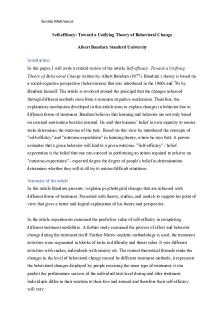Individual Assignment AF Giannis Chatziioannou EMBA18 PDF

| Title | Individual Assignment AF Giannis Chatziioannou EMBA18 |
|---|---|
| Course | Bussines |
| Institution | Yerevani Petakan Hamalsaran |
| Pages | 19 |
| File Size | 1.5 MB |
| File Type | |
| Total Downloads | 379 |
| Total Views | 545 |
Summary
See discussions, stats, and author profiles for this publication at: TESLA INC VALUATION , paper for Advanced Financial Management inRotterdam School of Management (RSM) Preprint DOI: 10.13140/RG.2.2.17922 0 1 author:Some of the authors of this publication are also working on these related projects:...
Description
See discussions, stats, and author profiles for this publication at: https://www.researchgate.net/publication/329586553
TESLA INC VALUATION , paper for Advanced Financial Management in Rotterdam School of Management (RSM) Preprint · June 2018 DOI: 10.13140/RG.2.2.17922.12480
CITATIONS
READS
0
2,373
1 author: Ioannis Chatziioannou Rotterdam School of Management 2 PUBLICATIONS0 CITATIONS SEE PROFILE
Some of the authors of this publication are also working on these related projects:
Tesla Inc Valuation View project
All content following this page was uploaded by Ioannis Chatziioannou on 12 December 2018.
The user has requested enhancement of the downloaded file.
Individual Assignment , Advance Finance,
Giannis Chatziioannou, EMBA18
Giannis Chatziioannou June 27th, 2018 Rotterdam School of Management, Erasmus University
Prepared for: Prof. Ronald Poppe Professor of Advanced Financial Management in Rotterdam School of Management (RSM), Erasmus University Rotterdam, Director of GELANA FINANCE Group
Page 1 of 18
Individual Assignment , Advance Finance,
Giannis Chatziioannou, EMBA18
Contents Rotterdam School of Management, ......................................................................................................................1 Erasmus University ................................................................................................................................................1 1. Executive summary.............................................................................................................................................3 1.1 Purpose of the report ........................................................................................................................3 1.2 Assumptions.......................................................................................................................................3 2. Company’s Profile ...............................................................................................................................................3 2.1. Business Description ...........................................................................................................................3 2.2. Industry outlook..................................................................................................................................3 3. Model 3...............................................................................................................................................................4 4. Management ......................................................................................................................................................5 5. Valuation Problem ..............................................................................................................................................5 6. Valuation.............................................................................................................................................................6 6.1 DCF .......................................................................................................................................................6 6.2 Using multiples ................................................................................................................................. 10 7. Recommendations ........................................................................................................................................... 12 8. Appendixes ...................................................................................................................................................... 13
Page 2 of 18
Individual Assignment , Advance Finance,
Giannis Chatziioannou, EMBA18
1. Executive summary 1.1 Purpose of the report The purpose of this report is to assess one of the most attractive company in the automotive industry at the moment, Tesla Motors, Inc (ticker TSLA). Its focus only on electric vehicles (EV) and the subsequent innovations and technology that this focus entails together with a great design have magnetized the attention of people from all over the world. Tesla has recently launched a new model, namely Model 3, that it supposed to be the EV for the masses, targeted at 35,000 USD drive away price. Until not it received thousands of pre-orders becoming one of the most popular brands in this industry at this early stage of their development. We will try to make a valuation of the company by comparing different valuations methods. Subsequently, those will be followed by a recommendation of sell/hold/buy shares of the Roche (ticker: TSLA). We will accentuate on Model 3, potential growth and market positioning in the future. Finally we will benchmark TSLA against the big players in automotive industry.
1.2 Assumptions In order to measure the value of the company, different assumptions have been taken into account. Below you. The realization of the underlying assumptions will determine the recognition of the analysis in the future (please see Appendix A)
2. Company’s Profile Name: TESLA Motors, Inc. Ticker: TSLA Exchange: NASDAQ Number of shares of common stock outstanding: 165.950.000 (as of December 2017) Sector: Manufacturing Industry : Automotive
2.1. Business Description Tesla Motors is a manufacturer of electric vehicles and powertrain components. Tesla sells its vehicles through its own network of stores worldwide. Its current product offerings include the Model S luxury sedan and Model X luxury utility vehicle. The Model 3 mass market vehicle is expected to launch at the end of 2017. Tesla is developing its network of supercharger charging stations in NA and Europe, and has announced plans to build a large scale lithium-ion battery manufacturing facility to serve its automotive business and the stationary energy storage market.
2.2. Industry outlook. The automobile industry is s highly cyclical business. The industry is closely tied to economical cycles and prices, and macro factors need therefore be analysed carefully to determine the future potential of the industry. We expect global automotive sales to have a 2% CAGR from 2015 to 2020. We expect global premium vehicle segment sales to have a 4.5% CAGR from 2013 to 2020E. We forecast TSLA Page 3 of 18
Individual Assignment , Advance Finance,
Giannis Chatziioannou, EMBA18
to achieve a approx. 3.5% share of the global premium segment and a 6.5% share of the North America premium segment by 2020.
Source : Reuters Thompson
3. Model 3 As many analysts have pointed out, TLSA on the $35k base Model 3 (no extras at all) would lose approx. $6k. Naturally, TSLA will try to avoid to sell Model 3’s at the price point that lose money, hence it’s fair to assume that the long term average selling price (ASP) will be around of $45k, which gives TSLA an operational margins (OM) of 4% and a gross margins (GM) just north of 15%. In other words they will miss its 25% gross margin target for the Model 3 (that supposedly will be the most profitable), which lead us to believe that TLSA will need to raise capital within 2019. In early August 2018, a configurable Model 3's range in price from $49k (cheapest) to $81k (all options). This price range addresses 45% of the luxury sedan market. As seen below (figure 1), the most common pricing (18% of lux vehicles) comes in between $45-50k. This fact alone indicates that a lot of competition will come not only by other EV models but from the old-good petrol/diesel engine motored luxury sedans. Moreover, EV competition will accelerate with more and more brands creating a full electric (Jaguar, BWM, Mercedes, VW, Porsche, Infiniti)1 or a hybrid (Ferrari, Maserati). To our estimates we can identify three challenges to volume targets (currently at 6000 Model 3 per week)2, particularly if TSLA targets an ASP of $50k. a) The +$50k priced sedan market is small. In the US, +$50k lux sedan market was ~0.5m units last year (~50% of 1m US lux sedan market). b) TLSA’s near term ability to compete in China, ~26% of global lux sedans, is impacted by the 40% US import tariffs (as counter-measure to Trump’s original import tariffs on Chinese steel and aluminium)
1
Among others: https://www.marketwatch.com/story/vw-maps-plan-to-overtake-tesla-in-electric-cars-2018-03-13 https://www.businessinsider.nl/elon-musk-tesla-model-3-production-ramp-plan-is-flawed-20184/?international=true&r=US
2
Page 4 of 18
Individual Assignment , Advance Finance,
Giannis Chatziioannou, EMBA18
c) TSLA does not have a strong global dealer footprint (less than 14% lux sales outside of China, US, and EU). It’s fair to assume that Model 3’s production will just be north of 300k by 2020, well short of its 500k production target3. (Currently, the production is lugging the 5000 per week mark. Blooberg have created an interactive map with all the latest on the production, retrievable at https://www.bloomberg.com/graphics/2018-tesla-tracker/ ). As comparison, the 5-yr average BMW 3-Series sales of 410k (340k ex China) & Mercedes C-Class sales of 430k (305k ex China) (both of them with an ASP around 40K.
Figure 1 Luxury Sedan Pricing Distribution & Model 3 Profitability
4. Management Departure of Dave Morton, Chief Accounting Officer, after 1 month on the job cannot be interpreted positively. This continues what appears to be an accelerating pace of senior management departures throughout the year. It was also announced that Chief People Officer Gaby Toledano would not return from a leave of absence just over a year after joining. There already voices echoing that Elon Musk, founder and major shareholder, should leave TSLA4, or at least bring some fresh minds to assist him because he looks like way too distracted with the many projects that he is involved (SolarEnergy, Space X, Hyperloop etc etc). This lack of attention is reflected in many of his actions or comments that badly affect TSLA's financial state and future. The recent incidents of bad conduct towards an analyst during an earning call5, the libertarian behaviour in a radio show or even the comments regarding taking TSLA private have plummeted the share price. Many investors would like to find a solution where Elon Musk could be involved in strategy but not the day-to-day operations of the company. In other words, there is a Musk premium in the share price. Depending on his behaviour could be high or low.
5. Valuation Problem Most traditional valuations and the theories on the subject, deals with mature companies. However, traditional valuation processes are challenged when faced with young and growing companies. The reason is that cash flows from operating activities are small and cash flows from investment activities 3
Tesla Motors, Fourth Quarter and Full Year 2013 Shareholde rs Letter. https://www.inc.com/erik-sherman/elon-musk-is-killing-tesla-heres-why-he-should-be-fired.html?cid=hmside1 5 https://globalnews.ca/news/4371324/tesla-shares-musk-apologizes/
4
Page 5 of 18
Individual Assignment , Advance Finance,
Giannis Chatziioannou, EMBA18
6
is significant . In the process of forecasting future cash flows based on past performance, investors are therefore faced with a challenge. Albeit, TSLA is operating almost as a start-up, the reality is that they operate in a mature business. We therefore believe that an analysis and valuation based on fundamental drivers, is reasonable approach to determine the actual value of the company. Furthermore, TSLA is not a “young” company anymore. Founded in 2003, have presented the Roadster (high performance), went public in 2010, year that they opened the mega-factory in Fremont. In 2012, TSLA launched the Model S and revealed the Model X that went in production in 2015. In 2014 they have expanded the assembly facility in the Netherlands, which deliver vehicles to the European market7. Lat year, was a very important year because the long expected high volume-low cost Model 3 started production along with the presentation of Tesla Semi (Truck), the first all-electric semi-truck.
Its true that real option valuation is more suited for a start-up or a technology company8, however to our humble opinion TSLA is neither. Its not a start-up any more (even if they act like that) and its not a technology company. Their only innovation has to do with making lithium -ion batteries a little bit more efficient then their competitors, but due to lack of financial means , they have partnered with Panasonic9 to further continue the research and development. The mere fact that R&D cost of TSLA is never exceeding 10% of its revenues (in comparison VW the last 10 years has an average of 8.7% and Toyota 8,6%, see Appendix B), which is not that much higher in relation to the spend of big and established players in the same industry (that in theory could afford not to evolve the internal combustion engines) In other words, TSLA is not a start-up, its not really innovative, they have just conceptualize and push through the idea of full electrified transportation. Being the first movers, gave them the competitive advantage and the spotlights. Nothing more, nothing less. For the problematics of real options valuation in companies , among others It would be wiser to use a combination of DCF valuation with multiples.
6. Valuation 6.1 DCF As of 2017, Tesla is not profitable. Actually they are burning more money that they can receive from their customers (see spreadsheet, tab ”TESLA Financials”. Profitability Ratio's
2017
ROE ROIC ( pre-tax) Operating Profit Margin - ROS
-35%
EBIT Sales Capital Turover Sales Invested capital LEVERAGE
6
-5%
-10% -1165 11,759 0.46 11,759 25,530 7.57
Damodaran, A. (2009), ”Valuing Young, Start -up and Growth Companies: Estimation Issues and Valuation Challenges”
7
Tesla Annual Report (2014), p. 13 For the problematic of real options valuation in companies , among others Mun, J. (2002). Real Option Analysis – Tools and Techniques for Valuing Strategic Investments and Decisions, New York : John Wiley & Sons. and Pablo Fernández, 2001, Valuing real options: frequently made errors, IESE Business School. 9 https://electrek.co/2018/05/10/tesla-panasonic-partner-again-gigafactory-china/ 8
Page 6 of 18
Individual Assignment , Advance Finance, Financial Structure Ratio Invested capital Equity Financial Cost Ratio
Giannis Chatziioannou, EMBA18
5.24 25,530 4,876 1.45 -1685 -1165
EBT EBIT Tax effect ratio
1.02
-1717 -1685
EAT EBT
Assets Turnover
0.44
We forecast that the number will improve only after 2020. Revenues
2018 E
Gross profit EBITDA Depreciation & amortisation EBIT Associates & investment income Other nonoperating income Net interest Exceptionals (incl goodwill) Profit before tax (EBT) Tax Profit after tax (EAT) Preference dividends Minorities Extraordinary items Revenues Gross profit
%change
2019 E
%change 2020 E
2021 E
2022 E
%change
19,990
70
24,788
24
27,763
31,094
34,825
12
3,444
52
3,814
46
4,214
4,657
5,146
10.5
1,415
200.5
2,236
58
2,773
3,438
4,264
24
-2,097
28.2
-2,433
16
-2,730
-3,063
-3,436
12.2
-682.0
-41%
-196.7
-71%
43.2
375.7
827.3
-122%
0
0
0
0
-1 -643
-33 42%
0 -1326
6%
0 -21%
-19 -1345
-680
-909.7
-31%
167.0 -22%
-742.7
-45%
0
0
0
-39
-40
-40
-680
-680
-680
0
0
0
-675.8
-344.3
107.3
61.0
43.0
1.0
-614.8
-301.3
108.3
0
0
0
0
0
220
261
234
234
234
0
0
0
0
0
-1125
-481.7
-380.8
-67.3
342.3
The average sales growth for the years 2014 to 2017 is approx. 70% (see appendix C). We assume that also in year 2018 that are the first deliveries of Model 3, the growth sales will remain around 70%. For 2019 we assumed a lower growth of 24% and for the 3 subsequent years growth of 12%. (see spreadsheet , under the tab “ TESLA Financials”).
Page 7 of 18
Individual Assignment , Advance Finance,
Giannis Chatziioannou, EMBA18
In our DCF calculation, we found that the share price of TSLA is 177,6 USD. We calculated WACC at 7.3%, which is exactly the value that external sources are mentioning. In our assumptions, we calculated the growth rate as 3,5% (which is realistic for a company like TSLA)10 Dec-18 EBITDA
1,415
Dec19 2,236
2,433 -682 -196.7
D&A
-2,097
EBIT Pro forma Taxes NOPAT Capital Expenditure s NWC Difference
Dec-20
Dec-21
Dec-22
2,773
3,438
4,264
-2,730
-3,063
-3,436
43.2
376
827
-19
167
61
43
1
-663
-364
-18
333
826
-2,465 -3,800
-2,500
-2,500
-2,700
357
-78
594
93
70
(+) D&A
2097
2433
2730
3063
3436
Free Cash Flow
-674 1,809
806
989
1,632
Terminal Value
44,458 3.5%
Growth Rate
7.30%
WACC NPV-Terminal Value Shares Value per Share Net Debt Equity Value of the Company
Sourc e
https://www.gurufocus.com/term/wacc/TSLA/WACC/Tesla%2BIn c
29477.7 8 165.96
177.6 13,174 16303.8
WACC (1) Risk-Free Rate* (2) Beta (3) Risk Premium** Cost of Equity: (1)+(2*3) Equity
2.30% 2 7.10% 16.5% 31% 4,876
10
GDP Growth Rate in the United States averaged 3.22 percent from 1947 until 2018, reaching an all time high of 16.70 percent in the first quarter of 1950 and a record low of -10 percent in the first quarter of 1958, retrievable in (https://tradingeconomics.com/united-states/gdp-growth )
Page 8 of 18
Individual Assignment , Advance Finance, Cost of Debt 4.3% Debt 10,905 69% Tax Rate WACC
Giannis Chatziioannou, EMBA18
25% 7.3%
Using the Golden Shapiro valuation model the share price is 166, we ...
Similar Free PDFs

Individual Assignment
- 26 Pages

Individual Assignment
- 20 Pages

Individual assignment
- 5 Pages

Individual assignment
- 3 Pages

MGT 162 INDIVIDUAL ASSIGNMENT
- 24 Pages

finance - individual assignment
- 7 Pages

Mkt individual assignment
- 4 Pages

BUS assignment individual
- 7 Pages

Report - Assignment 2 : Individual
- 11 Pages

Individual Assignment 1
- 1 Pages

Individual Assignment DSC651
- 6 Pages
Popular Institutions
- Tinajero National High School - Annex
- Politeknik Caltex Riau
- Yokohama City University
- SGT University
- University of Al-Qadisiyah
- Divine Word College of Vigan
- Techniek College Rotterdam
- Universidade de Santiago
- Universiti Teknologi MARA Cawangan Johor Kampus Pasir Gudang
- Poltekkes Kemenkes Yogyakarta
- Baguio City National High School
- Colegio san marcos
- preparatoria uno
- Centro de Bachillerato Tecnológico Industrial y de Servicios No. 107
- Dalian Maritime University
- Quang Trung Secondary School
- Colegio Tecnológico en Informática
- Corporación Regional de Educación Superior
- Grupo CEDVA
- Dar Al Uloom University
- Centro de Estudios Preuniversitarios de la Universidad Nacional de Ingeniería
- 上智大学
- Aakash International School, Nuna Majara
- San Felipe Neri Catholic School
- Kang Chiao International School - New Taipei City
- Misamis Occidental National High School
- Institución Educativa Escuela Normal Juan Ladrilleros
- Kolehiyo ng Pantukan
- Batanes State College
- Instituto Continental
- Sekolah Menengah Kejuruan Kesehatan Kaltara (Tarakan)
- Colegio de La Inmaculada Concepcion - Cebu




